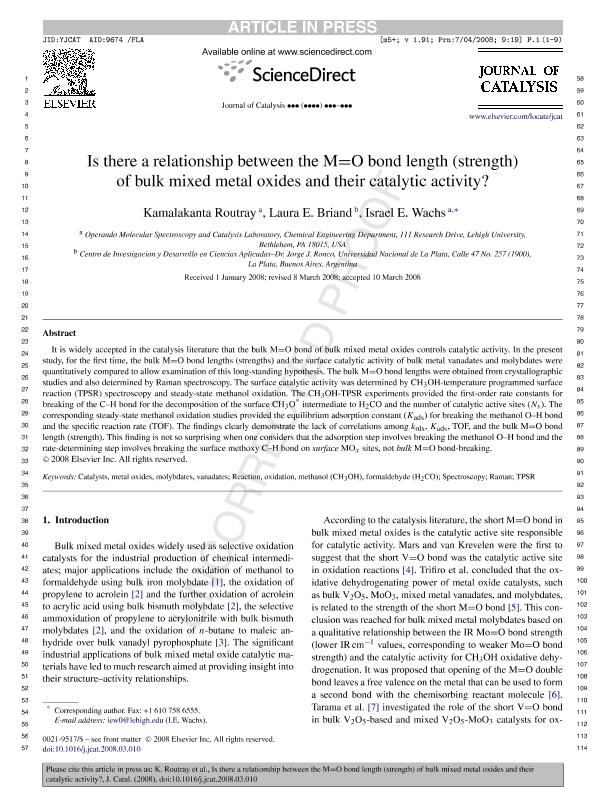Artículo
Is there a relationship between the M=O bond length (strength) of bulk mixed metal oxides and their catalytic activity?
Fecha de publicación:
10/03/2008
Editorial:
Elsevier
Revista:
Journal Of Catalysis
ISSN:
0021-9517
Idioma:
Inglés
Tipo de recurso:
Artículo publicado
Clasificación temática:
Resumen
It is widely accepted in the catalysis literature that the bulk M=O bond of bulk mixed metal oxides controls catalytic activity. In the present study, for the first time, the bulk M=O bond lengths (strengths) and the surface catalytic activity of bulk metal vanadates and molybdates were quantitatively compared to allow examination of this long-standing hypothesis. The bulk M=O bond lengths were obtained from crystallographic studies and also determined by Raman spectroscopy. The surface catalytic activity was determined by CH3OH-temperature programmed surface reaction (TPSR) spectroscopy and steady-state methanol oxidation. The CH3OH-TPSR experiments provided the first-order rate constants for breaking of the C?H bond for the decomposition of the surface CH3O* intermediate to H2CO and the number of catalytic active sites Ns. The corresponding steady-state methanol oxidation studies provided the equilibrium adsorption constant Kads for breaking the methanol OH bond and the specific reaction rate (TOF). The findings clearly demonstrate the lack of correlations among krds, Kads, TOF, and the bulk M=O bond length (strength). This finding is not so surprising when one considers that the adsorption step involves breaking the methanol OH bond and the rate-determining step involves breaking the surface methoxy CH bond on surface MO sites, not bulk M=O bond-breaking.
Archivos asociados
Licencia
Identificadores
Colecciones
Articulos(CINDECA)
Articulos de CENTRO DE INV EN CS.APLICADAS "DR.JORGE J.RONCO"
Articulos de CENTRO DE INV EN CS.APLICADAS "DR.JORGE J.RONCO"
Citación
Routray, Kamalakanta; Briand, Laura Estefania; Wachs, Israel E.; Is there a relationship between the M=O bond length (strength) of bulk mixed metal oxides and their catalytic activity?; Elsevier; Journal Of Catalysis; 256; 1; 10-3-2008; 145-153
Compartir
Altmétricas




